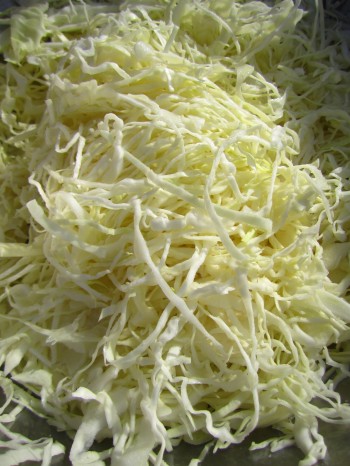11 Jan Simple countertop sauerkraut
To make this low-tech lacto-fermented sauerkraut, no special equipment is necessary, just a couple of jars with lids. For the veggies in this recipe, visit Blooming Glen Farm this weekend at the Wrightstown Mini-Market on Saturday, January 14th from 10-11am. They will have available their super sweet greenhouse grown carrots, field cabbage and more!
Chop fine 1 medium-large green cabbage (or equivalent).
Shred one carrot (optional) and mix in with the cabbage in a big bowl.
Sprinkle 1-2 tablespoons of natural, non-iodized sea salt over the veggies and stir it in. Taste a piece of cabbage– it should taste good and salty, like the ocean. If not add more salt.
Add 1/4 teaspoon caraway seeds and a few juniper berries (optional).
With a mallet or potato masher, pound your cabbage in the bowl for several minutes until it is nice and bruised to help water escape. Let rest for a few minutes with a plate and weight on top, go back and pound for a few minutes, and so on. When the mixture is too watery to pound well, you’re ready to jar it.
In 2 or 3 wide-mouth quart jars (or whatever size jars you have), pack in your kraut mixture as firmly as you can. You can do this with clean hands or handy kitchen utensils. Pour the remaining liquid equally into the jars. There should be enough liquid to cover your cabbage– if not, make a little more salty water and pour it in. Be sure to leave a couple of inches of head space at the top of each jar because kraut needs room to expand– otherwise it will fizz cabbage juice all over your counter top or even worse, your jar will explode. When everything is packed in and submerged, screw on your lids.
Leave the kraut to ferment on your countertop for 3-5 days (or more depending on taste). It will ferment faster in warmer weather. Check on the contents every day or so and mash the cabbage back under the liquid with a spoon. It should smell cabbagy but sweet– an offensive rotting odor means your ferment has gone awry and you’ll need to start over– try more salt or liquid next time, which helps favor the beneficial lactobacilli bacteria that do the fermentation magic.
When the kraut is to your liking store it in the fridge where it can last several months.
Recipe submitted by Grace Rollins.
Grace Rollins, M.S., L.Ac. is a licensed acupuncturist and a candidate for certification as a Nutritional Therapist. She is the owner of Bridge Acupuncture and Natural Health in Doylestown, PA (www.bridgeacupuncture.com), leader of the Bucks County Chapter of the Weston A. Price Foundation (www.westonaprice.org), and an avid cook, athlete and martial artist. She joined her first CSA in 2002.






Sorry, the comment form is closed at this time.